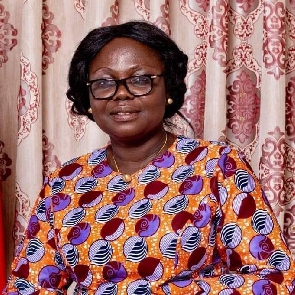


 Bono Regional Minister, Justina Owusu Banahene
Bono Regional Minister, Justina Owusu Banahene
The Bono Regional Minister, Justina Owusu Banahene has appealed to the Chiefs and Citizens of Hani-Begho, of the Tain District to be fierce in their passion to protect and preserve history and cultural heritage in the area.
Speaking at the Commissioning of Hani-Begho Community Museum, jointly founded by France Embassy and Archaeology Department of University of Ghana, Legon noted that art, literature, music, poetry, architecture are some of the hallmarks of human existence.
Mrs Owusu Banahene said they form a common thread that unites all citizens and their history.
The people Hani-Begho believed that their ancestors emanated from underground through a tiny hole. However, there are some Archaeology features at the town that support their claims, according to Archaeology Department of the University of Ghana which conducted some research about the history of the town.
The research focused on the extent to which the bio-archaeological study of human remains from the Hani-Begho community can bolster understanding of the anthropology of death and archaea thanatological practices at the site.
Hani-Begho is an ancient community within the Tain District of the Bono Region of Ghana,
Justina Owusu Banahene believed that history and cultural heritage defines humanity and it plays a quantifiable and crucial part of the health of human species.
She again added that traditional knowledge is at the core of indigenous identity, culture, languages, heritage and livelihoods, and its transmission from one generation to the next must be protected, preserved and encouraged,
According to the Regional Minister, as a people in this area with such a strong background, they should not and cannot let any circumstances erase their history and identity.
She said any loss of cultural heritage is a loss of our common memory. It impairs our ability to learn, to build experience, and to apply lessons of the past to the present and the future.
Mrs Owusu Banahene reminded Nananom that they are custodians of their own History and there is a need to engage their children, citizens and the world to have such events that motivate the society to keep our culture.”
Justina Owusu Banahene noted that people of Hani-Begho has tangible history and cultural heritage that should be recognised as such by the communities, and it should be maintained and transmittted worldwide for tourism purpose.
Heritage refers to practices or characteristics that are passed down through the years, from one generation to the next.
It is the task of every citizen of Hani-Begho to ensure that their heritage is preserved and passed down to next generation for them to become the custodians of the heritage in near future
Traditional knowledge is at the core of indigenous identity, culture, languages, heritage and livelihoods, and its transmission from one generation to the next must be protected, preserved and encouraged,
According to an article published on 2019, with caption: Contributions of Bioarcheology to Understanding the Past: A Study of Excavated Human Skeletons from Hani-Begho, Ghana. The researcher subjected the ancient skeletal remains from Hani-Begho, in the storage of the Museum of Archaeology of the University of Ghana, to an in-depth bio-archaeological analysis.
The article continued that skeletal remains that were dug revealed eight individuals from Hani-Begho, five females and three males, which can be dated by reference to materials from the site to between the 11th and 15th centuries.
The article said it was based on the idea that human skeletal remains have the potential to provide insights into the past.
The researcher focused on the extent to which the bioarcheological study of human remains from the Hani-Begho site can bolster understanding of the anthropology of death and archaeothanatological practices at the site.
According to the Researcher, dead body treatments by then varied considerably in Hani-Begho’s social, cultural and religious parameters, for example Chromolaena odorata (Acheampong) leaves and schnapps were used to preserve dead bodies.
Currently almost all the remains and other samples taken away have since been returned to stock the new Hani-Begho Community Museum.
Mr Daniel Kumah is the researcher and a Lecturer, Archaeology department of the University of Ghana later in an interview said the Region had several archaeological sites including, Bono Manso Kunsu and even Sunyani that can be developed to enhance tourism.